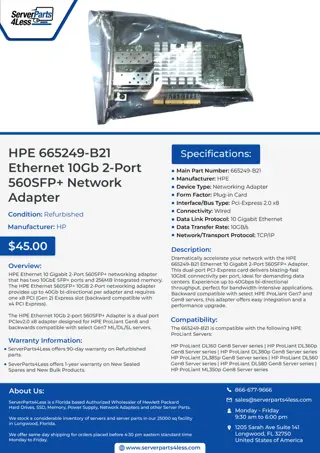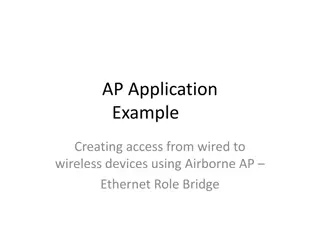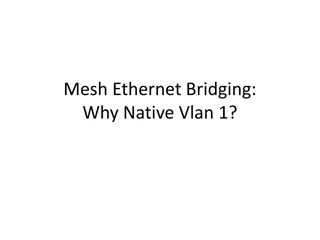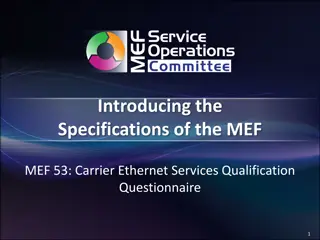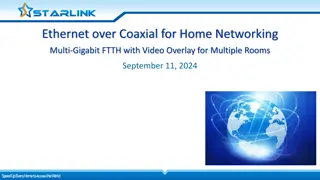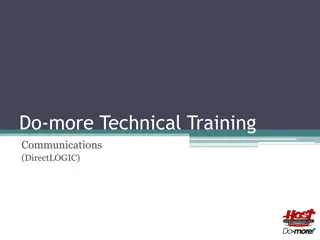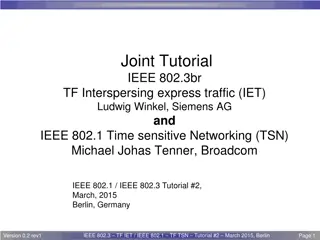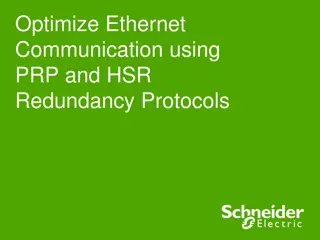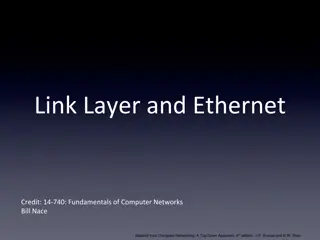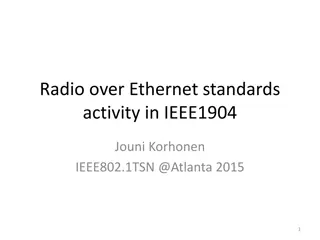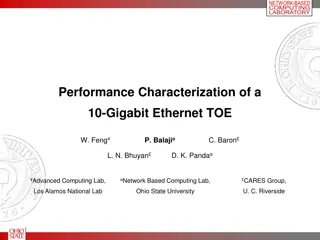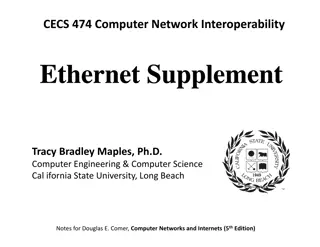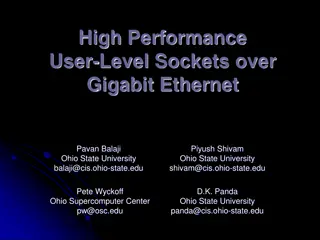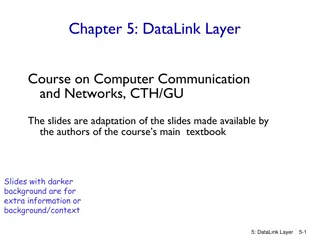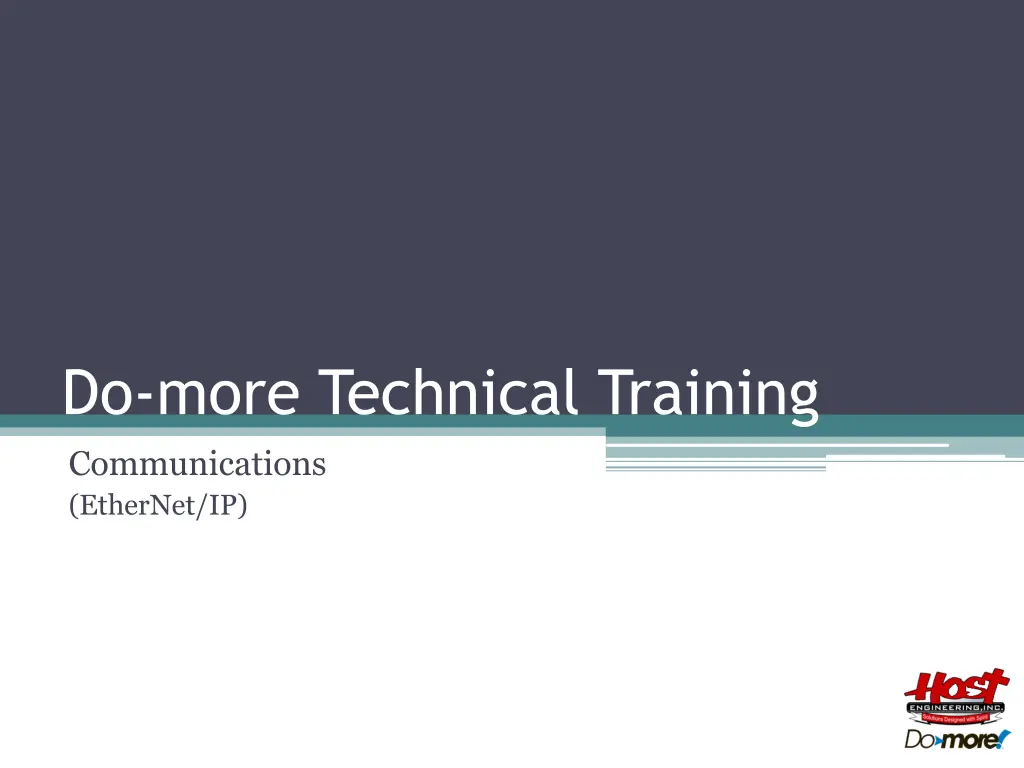
Advanced EtherNet/IP Technical Communications Training
Discover in-depth technical training on EtherNet/IP communications for Do-more programmable logic controllers. Learn about configuring EtherNet/IP servers, clients, message handling, and best practices for efficient communication setup.
Download Presentation

Please find below an Image/Link to download the presentation.
The content on the website is provided AS IS for your information and personal use only. It may not be sold, licensed, or shared on other websites without obtaining consent from the author. If you encounter any issues during the download, it is possible that the publisher has removed the file from their server.
You are allowed to download the files provided on this website for personal or commercial use, subject to the condition that they are used lawfully. All files are the property of their respective owners.
The content on the website is provided AS IS for your information and personal use only. It may not be sold, licensed, or shared on other websites without obtaining consent from the author.
E N D
Presentation Transcript
Do-more Technical Training Communications (EtherNet/IP)
Communications EtherNet/IP EtherNet/IP Explicit Message Server (Slave) Do-more built-in Ethernet port EtherNet/IP Explicit Message Client (Master) Do-more built-in Ethernet port
Communications EtherNet/IP EtherNet/IP Explicit Message Server (Slave) Do-more built-in Ethernet port EtherNet/IP Explicit Message Server (Slave) must be enabled & configured Use CPU Configuration EtherNet/IP Explicit Message Server, check the Enable EtherNet/IP Server box Use <EtherNet/IP Settings > button to change parameters as desired Configuration creates $IntEIPServer structure with members: ActiveSessions (unsigned byte) # of concurrent open connections LastError (unsigned byte) error code of last failed transaction Errors (unsigned word) # of failed transactions Transactions (signed double-word) # of successful transactions Serves up the Blocks as defined Can have up to 16 Clients (Masters); default = 4 EtherNet/IP uses TCP so TCP session must be established Configure up to 8 Blocks Default TCP Parameters These 4 parameters are vitally important & must be matched by the Client by the Client These 4 parameters are vitally important & must be matched
Communications EtherNet/IP EtherNet/IP Explicit Message Client (Master) Do-more built-in Ethernet port One EtherNet/IP Explicit Message Client Device (@IntEIPClient) exists by default Use Device Configuration to change parameters as desired Timeout: milliseconds (ms) to wait for Server (Slave) to respond Retries: how many times to retry comm Inactivity Timeout: seconds to keep TCP connection alive due to inactivity (no EIPMSG being executed) before doing a TCP disconnect from the Server (Slave) Use EIPMSG instruction Multiple EIPMSG instructions can be used to same Server (Slave) If >1 Server (Slave), it is more efficient to create an EtherNet/IP Explicit Message Client Device for each one (see Modbus TCP slides for the detailed reason why)
Communications EtherNet/IP EIPMSG Send EtherNet/IP Message Reads/writes data from/to an EtherNet/IP Explicit Message Server (Slave) Fully asynchronous instruction Parameters: Device EtherNet/IP Explicit Message Client Device name IP Address Fixed or Variable; TCP Port (44818 default) Path Class, Instance, Attribute Service Specific Service: Get Attribute (14, 0x0E) read Set Attribute (16, 0x10) write Get ALL Attributes (1, 0x01) read Set ALL Attributes (2, 0x02) write Generic Service: any other service not named above Enable (self explanatory) On Success/On Error (ditto) Use Request Service Data Buffer gets selected automatically if setting an attribute (writing); length must match Use Response Service Data Buffer gets selected automatically if getting an attribute (reading) Generic Status Code this is defined by the EtherNet/IP server s documentation Extended Status use this if necessary
Communications EtherNet/IP EtherNet/IP Server (Slave) EtherNet/IP Client (Master) Do-more CPU Do-more CPU EIPMSG Blocks 1-8 @IntEIPServer @IntEIPClient
Communications EtherNet/IP Define Block1 in Do-more CPU Define Block1 in SIM on your PC Use EIPMSG instruction in CPU to write to SIM Use EIPMSG instruction in CPU to read from SIM Use EIPMSG instruction in SIM to write to CPU Use EIPMSG instruction in SIM to read from CPU Do-more 10.1.1.110 SIM 10.1.1.200 EIPMSG N10 Block1 EIPMSG D10 Block1

